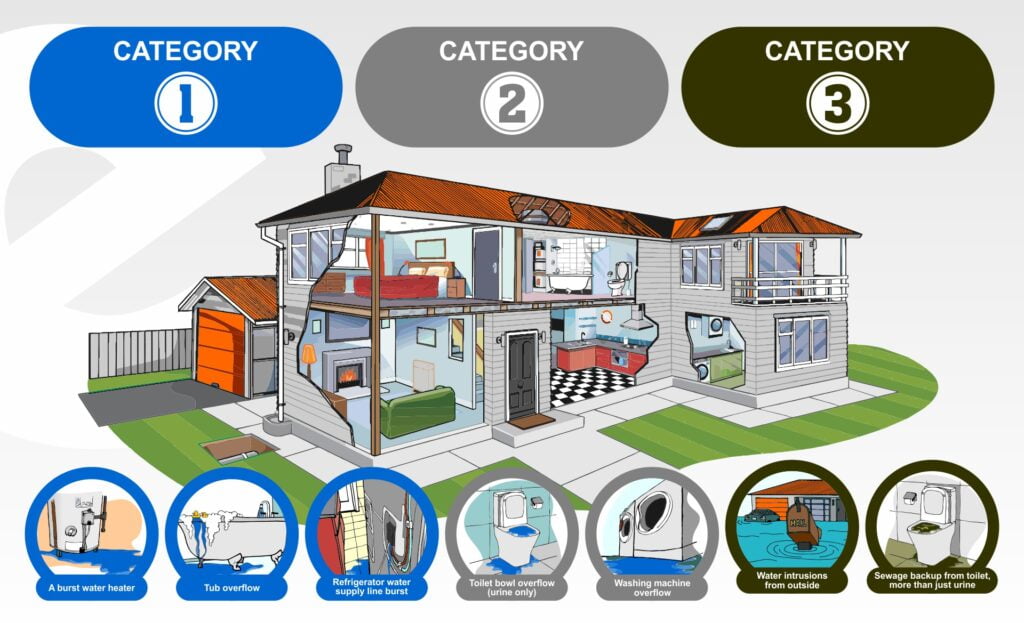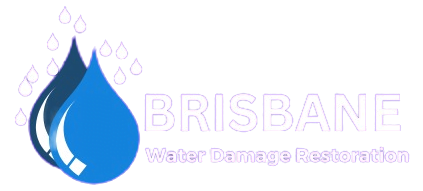Understanding the Various Types
of Water Damage Categories
UNDERSTANDING THE VARIOUS TYPES OF WATER DAMAGE CATEGORIES

Water damage can be a severe issue for both residential and commercial properties. Based on the source and extent of damage, the water damage can be categorised into different types. The Institute of Inspection Cleaning and Restoration Certification (IICRC), a globally recognised body, has formulated the IICRC S500 Standard that primarily classifies water damage into three categories. This article will delve into each of these water damage category types, providing a comprehensive understanding of what they entail and how they affect the mitigation process.
Category 1 - Defined
The first category in the IICRC S500 Standard is known as Category 1 water damage. This category encapsulates water damage where the source of water is uncontaminated and poses no immediate health risk. The water is often referred to as “clean water”.
Examples of Category 1 Water Damage
Some typical examples of Category 1 water damage can include:
A burst water supply line under a clean sink
Overflow from a bathtub or sink
Leakage or burst in the washing machine or refrigerator water supply line
Water from the tank on the back of the toilet
A burst water heater
In these instances, while the idea of drinking from a toilet tank or a burst water heater might seem unappealing, the water itself is free from contamination and therefore, does not pose a health hazard. However, if the water has an odour or if the water has been stagnant for a significant period, it may no longer be categorised as Category 1.
Category 2 - Explained
Category 2 water damage is more severe than Category 1. This category includes water that is visibly contaminated and can lead to illness or discomfort if ingested or contacted. The contaminants can be of various types, including chemical, biological, and physical.
Examples of Category 2 Water Damage
The typical sources of Category 2 water damage can be:
- Overflow from a toilet bowl with urine
- Overflow or leakage from a dishwasher or washing machine
- Water accumulated in carpets, especially the carpet pad
- Water in a ceiling or wall
While Category 2 water damage isn’t as severe as Category 3, it necessitates thorough cleanup and the use of Personal Protective Equipment (PPE) by technicians. If not addressed promptly, Category 2 water damage can escalate to Category 3.
Category 3 - Unveiled
Category 3 water damage is the most severe type. This category includes water that contains potentially toxic or hazardous substances. Exposure to Category 3 water can lead to serious illnesses or health risks.
Examples of Category 3 Water Damage
Some common examples of Category 3 water damage could include:
- Sewage backup
- Water intrusion from outside, possibly through cracks in the foundation
- Flooding from external sources
The risks associated with Category 3 water damage are not just limited to visible contaminants but also include potential threats from microorganisms that are not visible to the naked eye.
Safety Measures for Category 3 Water Damage
When dealing with Category 3 water damage, stringent safety measures must be adopted to protect both residents and workers. These measures can include:
- Adherence to OSHA guidelines and marking the affected areas as potentially hazardous
- Evacuation of individuals with health concerns from the area until it is deemed safe
- Use of Personal Protective Equipment (PPE)
- Deployment of appropriate decontamination processes
Unlike Category 1 and Category 2, Category 3 water damage requires extensive cleaning and removal of contaminated materials. The goal is to eliminate the toxicity and control the growth of microorganisms throughout the cleaning process.
Transitioning Between Categories
Certain scenarios may lead to the transition of water damage from one category to another. For instance, a Category 1 water damage situation can turn into Category 2 if not addressed promptly. Similarly, a Category 2 situation can escalate to Category 3 if left untreated. This transition is typically driven by the level of contamination and the duration for which the water has been stagnant.
Impact on Mitigation Costs
The costs associated with water damage restoration can vary significantly based on the category of water damage. While Category 1 water damage primarily requires water extraction and drying, Category 2 damage might involve additional cleaning and removal of contaminated materials. Category 3 water damage, being the most severe, requires extensive decontamination and disposal of contaminated materials, significantly increasing the associated costs.
Health Implications
Water damage, regardless of its category, can have severe health implications for both workers and residents. While the health risks are relatively lower for Category 1, the risks escalate with Category 2 and are severe for Category 3, which can cause serious illnesses due to the presence of toxic contaminants.
Impact on Property
In addition to health risks, water damage can significantly impact the structural and aesthetic integrity of a property. The effects can range from damaging building materials to promoting the growth of mould. While Category 1 damage has the least impact, Category 3 damage can lead to significant structural damage and degradation of the property’s aesthetic quality.
Special Considerations
Certain scenarios might not change the category of water damage but require special care during mitigation. For instance, water damage involving certain building materials might necessitate a specific approach to restoration.
Understanding the different categories of water damage is crucial to optimise the restoration process and ensure the safety of everyone involved. Whether you’re dealing with a minor leak or severe flooding, it’s vital to engage with experienced professionals who can effectively manage and mitigate the damage based on its category.
If you’re dealing with water damage in Brisbane, don’t panic! Our expert team is here to help you restore your property and get your life back on track. With years of experience and a commitment to providing top-notch service, we are the go-to company for water damage restoration in Brisbane. Our highly skilled technicians will assess the situation, develop a customised plan, and use state-of-the-art equipment to efficiently and effectively remove excess water, dry out affected areas, and prevent further damage. We understand that dealing with water damage can be stressful, but with our expertise and dedication, you can trust us to handle the job with professionalism and care. Don’t wait – call us now at Water Damage Restoration Brisbane and let us take care of your water damage worries.
